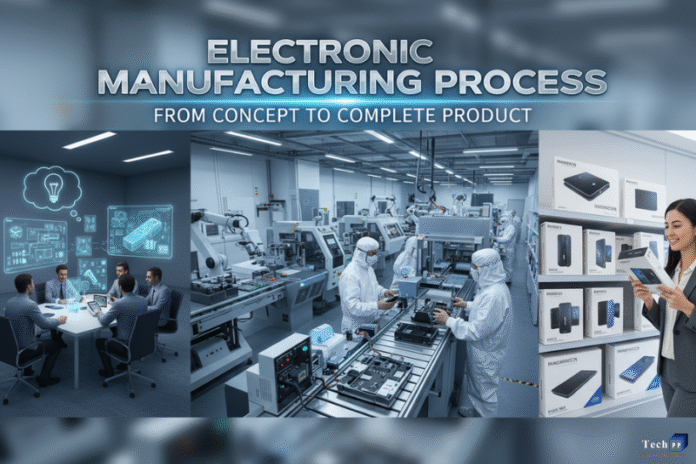The Electronic Manufacturing Process is the backbone of the modern electronics industry. It encompasses the design, production, testing, and assembly of electronic components and devices that power everything from smartphones and computers to medical equipment and automotive systems. This complex and highly technical process transforms a conceptual idea into a functional product ready for the market.
In today’s competitive environment, efficiency, accuracy, and innovation are essential throughout the Electronic Manufacturing Process. Each stage plays a crucial role in ensuring the reliability and performance of the final device, whether it’s a simple printed circuit board (PCB) or a multi-layered, high-speed electronic system.
Key Stages of the Electronic Manufacturing Process
1. Design and Development
The foundation of the Electronic Manufacturing Process begins with a robust design. Engineers and designers create detailed schematics and layouts for electronic circuits based on performance requirements, safety standards, and cost targets. Advanced CAD (Computer-Aided Design) software is used to model the circuitry and simulate performance before physical prototypes are developed.
At this stage, design for manufacturability (DFM) is essential. It ensures that the design can be efficiently produced with minimal errors, reducing time and cost in subsequent stages.
2. Component Procurement and Supply Chain Management
Once the design is finalised, the next step is sourcing electronic components. A reliable supply chain ensures consistent quality and availability of resistors, capacitors, microcontrollers, connectors, and other elements used in manufacturing.
Manufacturers must also manage risks associated with counterfeit parts and shortages. Effective supply chain management guarantees that only authentic and tested components are used in the Electronic Manufacturing Process, maintaining product integrity and compliance with industry standards.
3. PCB Fabrication
The printed circuit board (PCB) acts as the backbone of most electronic assemblies. During fabrication, layers of copper and insulating material are bonded together to form conductive pathways. Advanced PCBs can include multi-layer designs, high-frequency materials, or flexible substrates depending on the device’s needs.
Key steps include photolithography, etching, drilling, and plating, all performed with extreme precision. Proper PCB manufacturing ensures stable signal transmission, durability, and heat resistance — critical factors for overall product reliability.
4. PCB Assembly (PCBA)
Once the PCB is fabricated, components are mounted onto it using Surface Mount Technology (SMT) or Through-Hole Technology (THT).
- SMT Assembly: Components are placed on the surface of the PCB using automated pick-and-place machines. Solder paste is applied, and the board is passed through a reflow oven to create reliable solder joints.
- Through-Hole Assembly: Components with wire leads are inserted into drilled holes and soldered manually or using wave soldering.
The choice between SMT, THT, or a mixed approach depends on the design complexity, performance requirements, and product application.
5. Inspection and Testing
Testing is a critical stage of the Electronic Manufacturing Process. Automated Optical Inspection (AOI), X-ray analysis, and in-circuit testing (ICT) ensure that all components are correctly placed and function as intended.
Functional tests are also carried out to verify the complete system performance. For high-reliability industries such as aerospace or medical electronics, environmental and stress tests are performed to validate durability under various conditions.
6. Box Build Assembly and System Integration
In this stage, the assembled PCB is integrated into its enclosure or housing, along with cabling, connectors, and other mechanical elements. This step, often called box build assembly, transforms the electronic assembly into a complete, operational product.
Integration also includes software loading, calibration, and labelling — preparing the unit for shipment and final use.
7. Quality Assurance and Certification
A robust quality assurance (QA) framework is essential to maintain consistent standards. Each step of the Electronic Manufacturing Process adheres to international certifications such as ISO 9001, IPC-A-610, or RoHS compliance.
By implementing strict QA protocols, manufacturers ensure that products meet both customer and regulatory requirements, reducing returns and increasing end-user satisfaction.
8. Packaging and Logistics
Once all assemblies pass inspection, the products are carefully packaged to prevent damage during transit. Manufacturers also manage logistics and shipping to deliver the final product to the client or end-user efficiently.
Importance of the Electronic Manufacturing Process
The Electronic Manufacturing Process is the key to innovation and progress in nearly every industry. It determines how efficiently new technologies reach consumers and how reliably they perform over time.
Some of the major benefits of an optimised manufacturing process include:
- Enhanced Product Quality: Automated systems and precision assembly ensure consistent performance.
- Reduced Time-to-Market: Streamlined workflows allow faster prototype-to-production transitions.
- Cost Efficiency: Integrated systems and process automation reduce material waste and labour costs.
- Scalability: Manufacturers can easily adjust production volumes to meet varying market demands.
- Sustainability: Many modern facilities incorporate eco-friendly manufacturing techniques, such as lead-free soldering and energy-efficient machinery.
Modern Trends in the Electronic Manufacturing Process
The electronics industry is evolving rapidly, driven by advances in technology and global demand for smarter, more connected devices.
Some of the most influential trends include:
- Automation and Robotics: Enhancing precision and reducing human error in assembly lines.
- IoT Integration: Smart factories use real-time data monitoring to improve efficiency.
- Miniaturisation: As devices get smaller, PCB designs and manufacturing techniques must adapt to handle tiny components.
- Sustainability Initiatives: Environmentally friendly materials and processes are becoming standard.
- AI and Machine Learning: Used for predictive maintenance, defect detection, and production optimisation.
These advancements continue to shape the Electronic Manufacturing Process, making it faster, cleaner, and more intelligent than ever before.
Applications of Electronic Manufacturing
The process supports a wide range of industries, including:
- Consumer Electronics: Smartphones, wearables, and home appliances.
- Automotive: Electric vehicle control units, infotainment systems, and sensors.
- Medical: Diagnostic devices, patient monitors, and implantable electronics.
- Telecommunications: Network routers, antennas, and signal processors.
- Industrial Automation: Control systems and power management devices.
Each of these sectors depends on precise and efficient Electronic Manufacturing Processes to maintain quality, reliability, and scalability.
Conclusion
The Electronic Manufacturing Process is more than just a production method — it’s a strategic framework that drives innovation, reliability, and performance across industries. From concept design and PCB fabrication to final assembly and testing, every stage contributes to the success of an electronic product.
To achieve superior results, it’s essential to work with a trusted partner that provides comprehensive Electronics Manufacturing Services. Such experts combine advanced technologies, quality assurance systems, and engineering knowledge to deliver efficient and cost-effective manufacturing solutions.
By choosing a professional provider offering Electronics Manufacturing Services, businesses can streamline their operations, reduce costs, and bring high-quality electronic products to market with confidence and speed.


